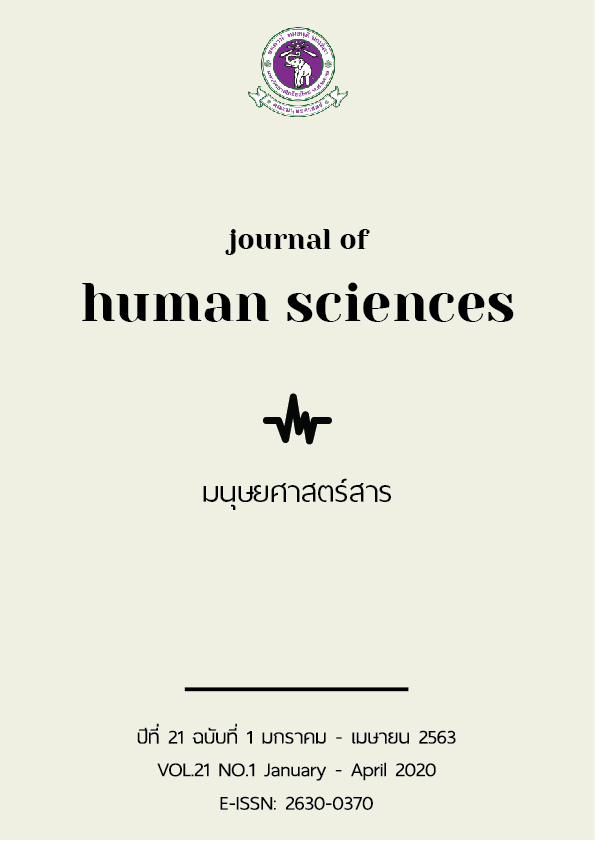การแปรของเสียง /t/ ระหว่างสระในกลุ่มผู้เรียนชาวไทย
Main Article Content
บทคัดย่อ
การศึกษานี้มีวัตถุประสงค์เพื่อศึกษาเสียง /t/ ระหว่างสระที่มีการแปรผันในภาษาอังกฤษ โดยสามารถแปรเป็น เสียงธนิต [tʰ] และเสียงแบน [ɾ] ในวัจนลีลาที่แตกต่างกัน 3 รูปแบบ ได้แก่ การสัมภาษณ์ การอ่านบทความสั้น ๆ และการอ่านรายการคำศัพท์ นักศึกษาเอกวิชาภาษาอังกฤษจำนวน 40 คน จากมหาวิทยาลัยในจังหวัดเชียงใหม่จำนวน 4 แห่ง เข้าร่วมในการศึกษาครั้งนี้จากการสุ่มตัวอย่างแบบจำเพาะเจาะจง เสียงแปรต่าง ๆ ที่ได้มาจากการออกเสียง /t/ จากวัจนลีลาทั้ง 3 รูปแบบได้รับการตัดสินจากเจ้าของภาษาอังกฤษ และจัดกลุ่มภายใต้คุณลักษณะของสำเนียงแบบบริทิช (Received Pronunciation) หรือสำเนียงแบบอเมริกัน (General American) และนำไปสู่การอภิปรายว่าสำเนียงใดเป็นที่นิยมมากกว่าท่ามกลางผู้เรียนชาวไทย ผู้วิจัยยืนยันผลการวิเคราะห์อีกหนึ่งครั้งเพื่อให้เกิดความน่าเชื่อถือของข้อมูล เสียงที่ยังไม่ชัดเจนจะได้รับการวิเคราะห์เพิ่มเติมโดยใช้โปรแกรมวิเคราะห์คำพูด ที่ชื่อว่า “PRAAT” เพื่อวิเคราะห์ลักษณะเสียงในเชิงลึก ผลการศึกษาบ่งชี้ว่าการแปรเสียง /t/ ระหว่างสระ เป็นเสียงธนิต [tʰ] ซึ่งเป็นคุณลักษณะของสำเนียงแบบบริทิช ได้รับการใช้อย่างแพร่หลายท่ามกลางนักศึกษาในสถาบันต่าง ๆ ดังนั้น จึงนับได้ว่าเสียง [tʰ] เป็นคุณลักษณะที่มีอิทธิพลที่นักศึกษาต้องการนำไปออกเสียง นอกจากนี้ ความนิยมต่อการออกเสียง [tʰ] ยังพบได้จากเปอร์เซ็นต์การออกเสียงที่ค่อนข้างสูงในการอ่านรายการคำศัพท์ ซึ่งนับว่าเป็นรูปแบบที่เป็นทางการมากที่สุด มากกว่าในวัจนลีลาแบบอื่น ๆ การทดสอบไคสแควร์ยังยืนยันอีกว่า ความตระหนักในการออกเสียง /t/ มีความสัมพันธ์อย่างมากกับวัจนลีลารูปแบบต่าง ๆ (χ2 = 17.11, df = 2, p<.01)
Article Details
เอกสารอ้างอิง
Foulkes, P., Docherty, G. J., & Jones, M. (2010). Analysing stops. In Sociophonetics: A Student’s Guide. London: Routledge.
Holmes, J. (2013). An Introduction to Sociolinguistics. London: Routledge
Jenkins, J. (2002). A Sociolinguistically based, empirically researched pronunciation syllabus for English as an International Language. Applied Linguistics, 23(1). 83–103.
Kanokpermpoon, M. (2007). Thai and English consonantal sounds: A problem or a potential for EFL learning?. ABAC Journal, 27(1). 57–66.
Kirkpatrick, A. (2007). World Englishes: Implications for International Communication and English Language Teaching. The Modern Language Journal, 92(4). 654–655.
Labov, W. (2006). The Social Stratification of English in New York City (2nd ed.). New York: Cambridge University Press.
Mooney, A., & Evans, B. (2015). Language, Society and Power: An Introduction. London: Routledge.
Roach, P. (2009). English Phonetics and Phonology: A Practical Course. New York:
Cambridge University Press.
Romaine, S. (1984). The Language of Children and Adolecents. Oxford: Blackwell.
Thieberger, N. (Ed.). (2012). The Oxford Handbook of Linguistic Fieldwork (1st ed.). Oxford: Oxford University Press.
Trudgill, P., & Hannah, J. (1994). International English: A Guide to Varieties of Standard English. London: E. Arnold.
Wardhaugh, R. (2010). An Introduction to Sociolinguistics (6th ed.). Hoboken, NJ: Blackwell.
Yaeger-Dror, M. (2001). Primitives of a system for style and register. In Style and Sociolinguistic Variation (pp. 170–185). Cambridge: Cambridge University Press.


